Analyzing Job Creation and the Circular Economy's Economic Effects
VerifiedAdded on 2020/07/23
|12
|3513
|360
Report
AI Summary
This report examines the circular economy's role in job creation and economic development. It begins with theoretical perspectives, defining the circular economy, its characteristics, and drivers, including the importance of circular supply chains. The report then analyzes the circular economy's impact on job creation, considering various scenarios and their implications for employment. The report also provides a practical perspective by analyzing Dell's business model and its strategies. The report concludes by emphasizing the circular economy's potential to foster economic growth, resource optimization, and sustainable business practices. The report highlights the importance of waste reduction, resource efficiency, and the development of new jobs within the circular economy, emphasizing the need for businesses to adopt circular models to achieve long-term sustainability.

Job Creation and the Circular
Economy
Economy
Paraphrase This Document
Need a fresh take? Get an instant paraphrase of this document with our AI Paraphraser
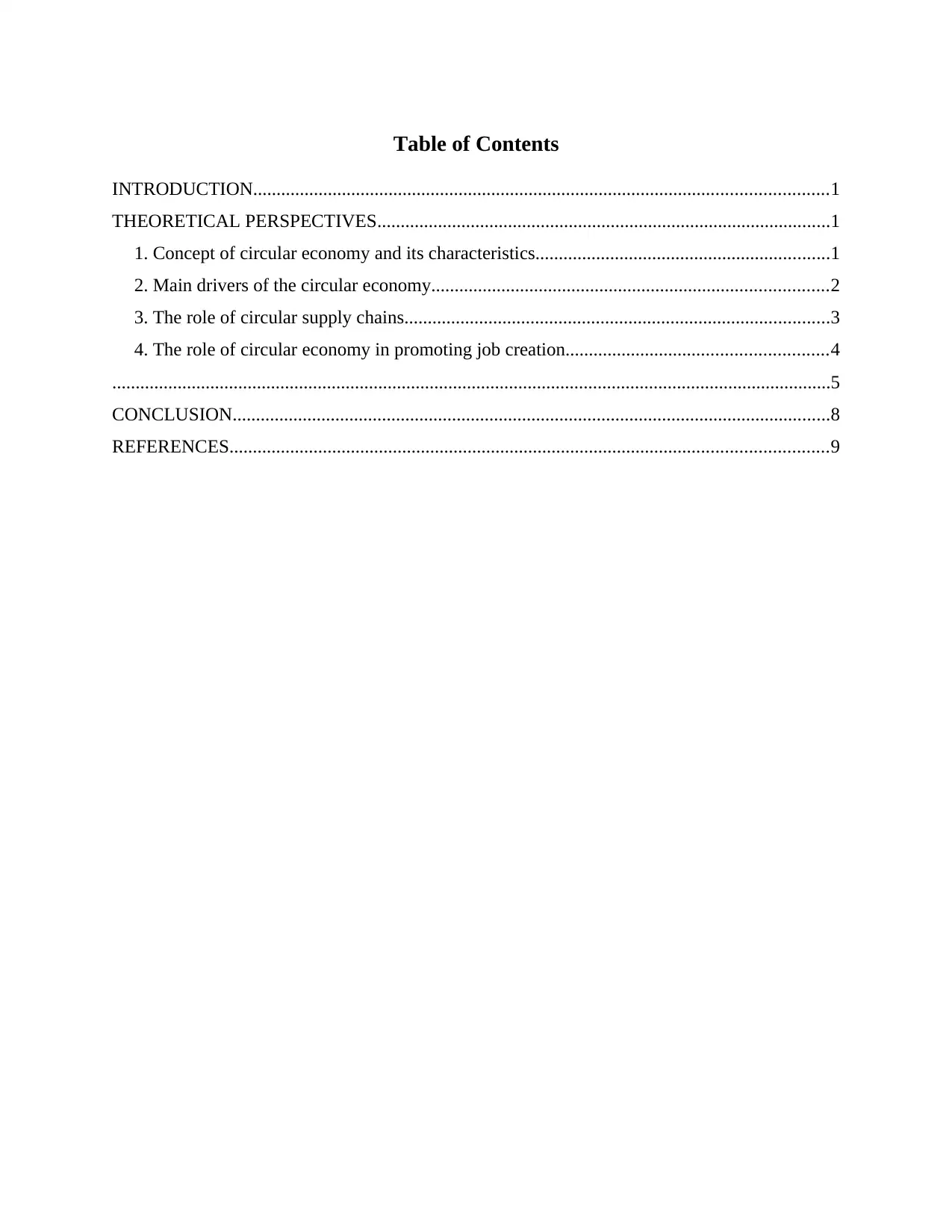
Table of Contents
INTRODUCTION...........................................................................................................................1
THEORETICAL PERSPECTIVES.................................................................................................1
1. Concept of circular economy and its characteristics...............................................................1
2. Main drivers of the circular economy.....................................................................................2
3. The role of circular supply chains...........................................................................................3
4. The role of circular economy in promoting job creation........................................................4
..........................................................................................................................................................5
CONCLUSION................................................................................................................................8
REFERENCES................................................................................................................................9
INTRODUCTION...........................................................................................................................1
THEORETICAL PERSPECTIVES.................................................................................................1
1. Concept of circular economy and its characteristics...............................................................1
2. Main drivers of the circular economy.....................................................................................2
3. The role of circular supply chains...........................................................................................3
4. The role of circular economy in promoting job creation........................................................4
..........................................................................................................................................................5
CONCLUSION................................................................................................................................8
REFERENCES................................................................................................................................9

INTRODUCTION
Economics is the major part for knowing any country's growth and development.
Economists frame policies so that any country can grow financially by opting them. In any
country, firms which are engaged in various sectors try to use their resources in an optimum
manner so that business will be able to boost the economy of that particular country in which
they are operating that would ultimately upgrade the society as they would get various job
opportunities (Zárate-Hoyos, 2014). In the present report, way in which the wastage is recycled
by the circular economy is explained to enhance the economic and social efficiency as well as
reduce their environmental impact will be analysed. Dell is one of those company who modifies
the existing software and products also and increase their total worth. Following report will
discuss who the company does this function and increase its total productivity.
THEORETICAL PERSPECTIVES
1. Concept of circular economy and its characteristics
Circular economy is an option to traditional linear efficiency under which company
makes use of their resources in an optimal manner so that they can produce maximum value out
of the same. Thereafter reuse the existing products and create utility out of each. Thereafter,
recover and re-generate goods and materials at the end of each service life. A concept which
distinguishes between technical and biological cycle is a regular and development interval. It
keeps and improves natural capital, optimal utilization of resources and minimizes system risk by
controlling definite stocks (Muegge, 2012). This operates effectively at each scale.
There are various characteristics of a circular economy which act as a principle for
action. There are the following fundamental characteristics which elaborate a clear circular
economy:
Design out waste: Wastage does not emerge when biological and technological factors
of a goods are specially framed with purpose. The biological components are non-toxic and
could easily be decomposed. . Technical materials such as polymers and other non-made
compounds are framed to be utilized again with less energy and the most quality retention.
Frame resilience via diversity: Modularity, versatility and acceptance are prized
characteristic which are required to be present in the current period. Many systems with various
links and scales are much resilient under external shock.
1
Economics is the major part for knowing any country's growth and development.
Economists frame policies so that any country can grow financially by opting them. In any
country, firms which are engaged in various sectors try to use their resources in an optimum
manner so that business will be able to boost the economy of that particular country in which
they are operating that would ultimately upgrade the society as they would get various job
opportunities (Zárate-Hoyos, 2014). In the present report, way in which the wastage is recycled
by the circular economy is explained to enhance the economic and social efficiency as well as
reduce their environmental impact will be analysed. Dell is one of those company who modifies
the existing software and products also and increase their total worth. Following report will
discuss who the company does this function and increase its total productivity.
THEORETICAL PERSPECTIVES
1. Concept of circular economy and its characteristics
Circular economy is an option to traditional linear efficiency under which company
makes use of their resources in an optimal manner so that they can produce maximum value out
of the same. Thereafter reuse the existing products and create utility out of each. Thereafter,
recover and re-generate goods and materials at the end of each service life. A concept which
distinguishes between technical and biological cycle is a regular and development interval. It
keeps and improves natural capital, optimal utilization of resources and minimizes system risk by
controlling definite stocks (Muegge, 2012). This operates effectively at each scale.
There are various characteristics of a circular economy which act as a principle for
action. There are the following fundamental characteristics which elaborate a clear circular
economy:
Design out waste: Wastage does not emerge when biological and technological factors
of a goods are specially framed with purpose. The biological components are non-toxic and
could easily be decomposed. . Technical materials such as polymers and other non-made
compounds are framed to be utilized again with less energy and the most quality retention.
Frame resilience via diversity: Modularity, versatility and acceptance are prized
characteristic which are required to be present in the current period. Many systems with various
links and scales are much resilient under external shock.
1
⊘ This is a preview!⊘
Do you want full access?
Subscribe today to unlock all pages.

Trusted by 1+ million students worldwide

Task towards energy from renewable sources: System’s main focus is to run on on
energy which is renewable in nature so that less power is consumed from surroundings. For
example, agro based system operates on existing solar scheme which will limit the requirement
for waste fuel inputs and capture much of the energy value by products.
Think in systems: There is a need to know about how various parts influence each other
and to know the link between each part is important. Sections are suggested to understand their
environmental and social matter. Although, a machine is kind of system, this is totally narrowly
bounded and presumed to be deterministic. Systems thinking basically means to the majority of
actual world system. Such systems are non-linear, feedback-rich and interdependent. Under these
systems, normal starting conditions merged with feedbacks which brought surprising issues,
which are not able to get controlled in the acceptable, linear sense. It required rather more
dynamic and adaptation to vary circumstances.
Thinks in cascades: For biological components, the most essential value was adding the
opportunity to get extra value from the goods and components by cascading them via other
applications. Under biological material, be it natural or in managed fermentation procedures,
component is separated in stages by micro-organisms such as bacteria and fungi which pull out
energy and other micronutrients from carbohydrates, proteins and fat found in the material
(Corrêa and Xavier, 2013).
These are the above mentioned characteristics of circular economy that are helpful for
making the country much developed.
2. Main drivers of the circular economy
Circular economy renders value adding tools which are decoupled from the usage of
scarce resources. In a great circular economy, consumptions only occurred in an efficient bio-
cycle and framed in the technical cycle. Life processes reproduce wastage materials without
human intervention under bio-cycle. But in the technical cycle, human intervention reproduce
materials and order by using enough energy. The circular economy have three principles, each
addressing various resources and system challenges that are faced by the industrial economies.
There are mainly three characteristics which are:
Preserve and improve natural capital: Such characteristic of circular economy starts
with dematerialising utility and rendering the use . If resources are required, the circular
tool chooses them after having extensive research and select technologies and processes
2
energy which is renewable in nature so that less power is consumed from surroundings. For
example, agro based system operates on existing solar scheme which will limit the requirement
for waste fuel inputs and capture much of the energy value by products.
Think in systems: There is a need to know about how various parts influence each other
and to know the link between each part is important. Sections are suggested to understand their
environmental and social matter. Although, a machine is kind of system, this is totally narrowly
bounded and presumed to be deterministic. Systems thinking basically means to the majority of
actual world system. Such systems are non-linear, feedback-rich and interdependent. Under these
systems, normal starting conditions merged with feedbacks which brought surprising issues,
which are not able to get controlled in the acceptable, linear sense. It required rather more
dynamic and adaptation to vary circumstances.
Thinks in cascades: For biological components, the most essential value was adding the
opportunity to get extra value from the goods and components by cascading them via other
applications. Under biological material, be it natural or in managed fermentation procedures,
component is separated in stages by micro-organisms such as bacteria and fungi which pull out
energy and other micronutrients from carbohydrates, proteins and fat found in the material
(Corrêa and Xavier, 2013).
These are the above mentioned characteristics of circular economy that are helpful for
making the country much developed.
2. Main drivers of the circular economy
Circular economy renders value adding tools which are decoupled from the usage of
scarce resources. In a great circular economy, consumptions only occurred in an efficient bio-
cycle and framed in the technical cycle. Life processes reproduce wastage materials without
human intervention under bio-cycle. But in the technical cycle, human intervention reproduce
materials and order by using enough energy. The circular economy have three principles, each
addressing various resources and system challenges that are faced by the industrial economies.
There are mainly three characteristics which are:
Preserve and improve natural capital: Such characteristic of circular economy starts
with dematerialising utility and rendering the use . If resources are required, the circular
tool chooses them after having extensive research and select technologies and processes
2
Paraphrase This Document
Need a fresh take? Get an instant paraphrase of this document with our AI Paraphraser
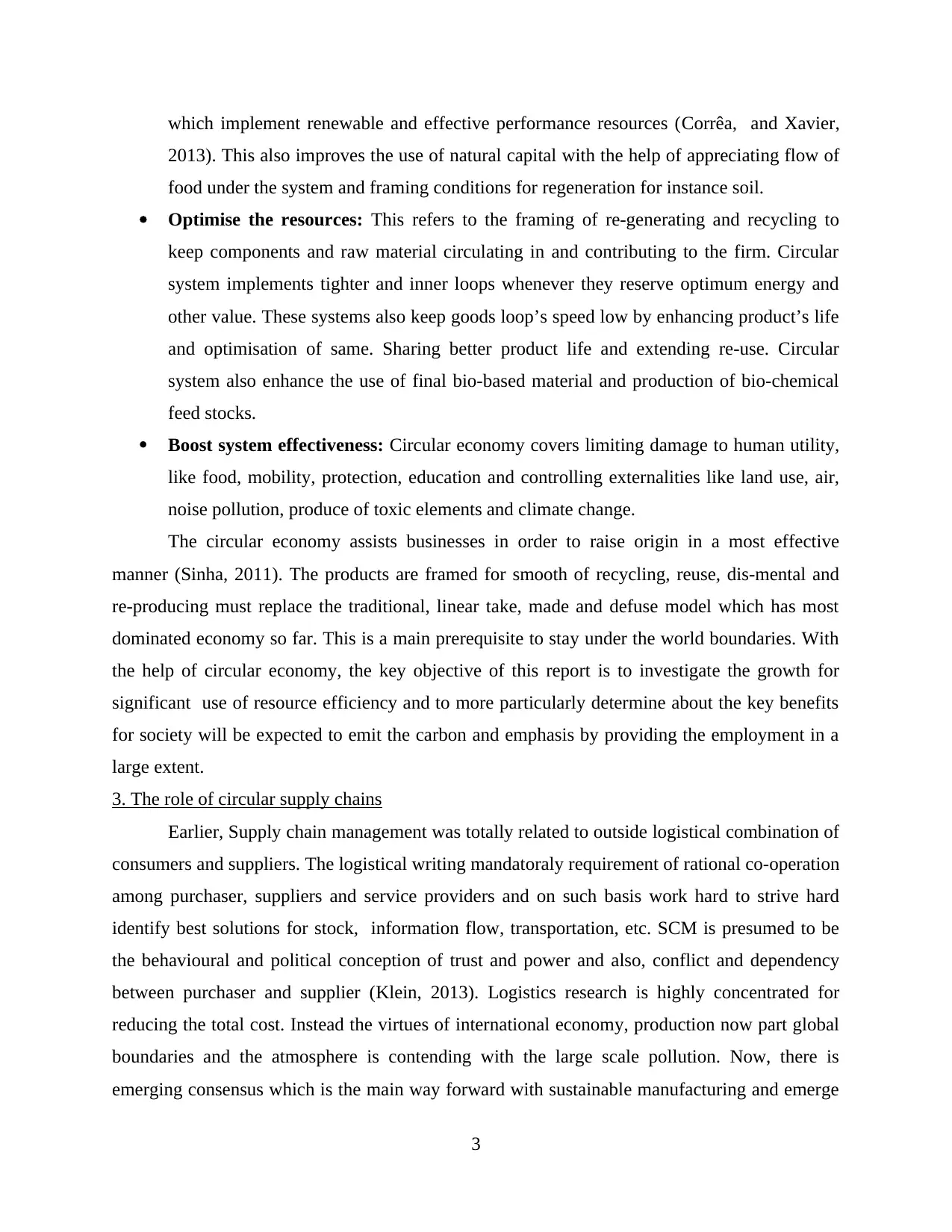
which implement renewable and effective performance resources (Corrêa, and Xavier,
2013). This also improves the use of natural capital with the help of appreciating flow of
food under the system and framing conditions for regeneration for instance soil.
Optimise the resources: This refers to the framing of re-generating and recycling to
keep components and raw material circulating in and contributing to the firm. Circular
system implements tighter and inner loops whenever they reserve optimum energy and
other value. These systems also keep goods loop’s speed low by enhancing product’s life
and optimisation of same. Sharing better product life and extending re-use. Circular
system also enhance the use of final bio-based material and production of bio-chemical
feed stocks.
Boost system effectiveness: Circular economy covers limiting damage to human utility,
like food, mobility, protection, education and controlling externalities like land use, air,
noise pollution, produce of toxic elements and climate change.
The circular economy assists businesses in order to raise origin in a most effective
manner (Sinha, 2011). The products are framed for smooth of recycling, reuse, dis-mental and
re-producing must replace the traditional, linear take, made and defuse model which has most
dominated economy so far. This is a main prerequisite to stay under the world boundaries. With
the help of circular economy, the key objective of this report is to investigate the growth for
significant use of resource efficiency and to more particularly determine about the key benefits
for society will be expected to emit the carbon and emphasis by providing the employment in a
large extent.
3. The role of circular supply chains
Earlier, Supply chain management was totally related to outside logistical combination of
consumers and suppliers. The logistical writing mandatoraly requirement of rational co-operation
among purchaser, suppliers and service providers and on such basis work hard to strive hard
identify best solutions for stock, information flow, transportation, etc. SCM is presumed to be
the behavioural and political conception of trust and power and also, conflict and dependency
between purchaser and supplier (Klein, 2013). Logistics research is highly concentrated for
reducing the total cost. Instead the virtues of international economy, production now part global
boundaries and the atmosphere is contending with the large scale pollution. Now, there is
emerging consensus which is the main way forward with sustainable manufacturing and emerge
3
2013). This also improves the use of natural capital with the help of appreciating flow of
food under the system and framing conditions for regeneration for instance soil.
Optimise the resources: This refers to the framing of re-generating and recycling to
keep components and raw material circulating in and contributing to the firm. Circular
system implements tighter and inner loops whenever they reserve optimum energy and
other value. These systems also keep goods loop’s speed low by enhancing product’s life
and optimisation of same. Sharing better product life and extending re-use. Circular
system also enhance the use of final bio-based material and production of bio-chemical
feed stocks.
Boost system effectiveness: Circular economy covers limiting damage to human utility,
like food, mobility, protection, education and controlling externalities like land use, air,
noise pollution, produce of toxic elements and climate change.
The circular economy assists businesses in order to raise origin in a most effective
manner (Sinha, 2011). The products are framed for smooth of recycling, reuse, dis-mental and
re-producing must replace the traditional, linear take, made and defuse model which has most
dominated economy so far. This is a main prerequisite to stay under the world boundaries. With
the help of circular economy, the key objective of this report is to investigate the growth for
significant use of resource efficiency and to more particularly determine about the key benefits
for society will be expected to emit the carbon and emphasis by providing the employment in a
large extent.
3. The role of circular supply chains
Earlier, Supply chain management was totally related to outside logistical combination of
consumers and suppliers. The logistical writing mandatoraly requirement of rational co-operation
among purchaser, suppliers and service providers and on such basis work hard to strive hard
identify best solutions for stock, information flow, transportation, etc. SCM is presumed to be
the behavioural and political conception of trust and power and also, conflict and dependency
between purchaser and supplier (Klein, 2013). Logistics research is highly concentrated for
reducing the total cost. Instead the virtues of international economy, production now part global
boundaries and the atmosphere is contending with the large scale pollution. Now, there is
emerging consensus which is the main way forward with sustainable manufacturing and emerge
3
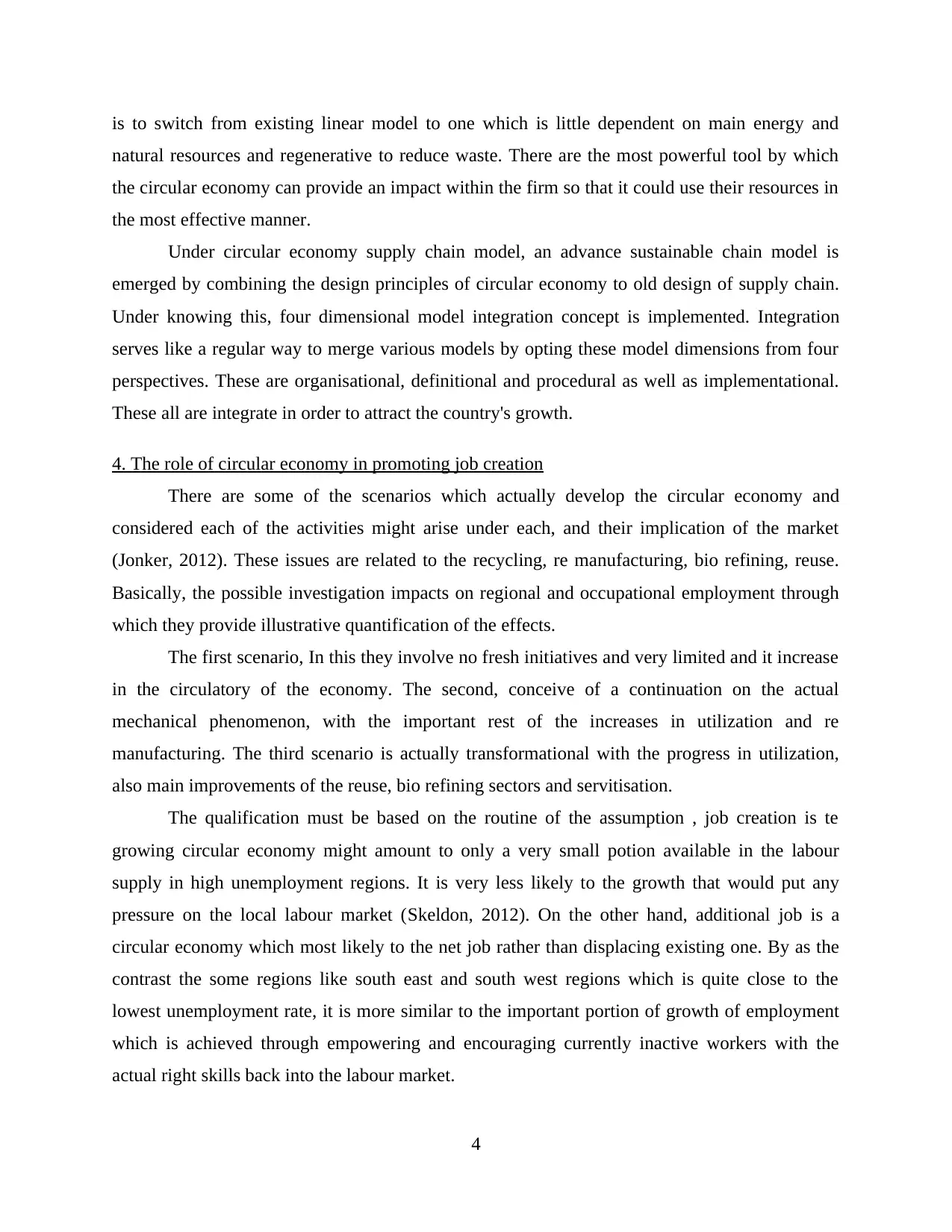
is to switch from existing linear model to one which is little dependent on main energy and
natural resources and regenerative to reduce waste. There are the most powerful tool by which
the circular economy can provide an impact within the firm so that it could use their resources in
the most effective manner.
Under circular economy supply chain model, an advance sustainable chain model is
emerged by combining the design principles of circular economy to old design of supply chain.
Under knowing this, four dimensional model integration concept is implemented. Integration
serves like a regular way to merge various models by opting these model dimensions from four
perspectives. These are organisational, definitional and procedural as well as implementational.
These all are integrate in order to attract the country's growth.
4. The role of circular economy in promoting job creation
There are some of the scenarios which actually develop the circular economy and
considered each of the activities might arise under each, and their implication of the market
(Jonker, 2012). These issues are related to the recycling, re manufacturing, bio refining, reuse.
Basically, the possible investigation impacts on regional and occupational employment through
which they provide illustrative quantification of the effects.
The first scenario, In this they involve no fresh initiatives and very limited and it increase
in the circulatory of the economy. The second, conceive of a continuation on the actual
mechanical phenomenon, with the important rest of the increases in utilization and re
manufacturing. The third scenario is actually transformational with the progress in utilization,
also main improvements of the reuse, bio refining sectors and servitisation.
The qualification must be based on the routine of the assumption , job creation is te
growing circular economy might amount to only a very small potion available in the labour
supply in high unemployment regions. It is very less likely to the growth that would put any
pressure on the local labour market (Skeldon, 2012). On the other hand, additional job is a
circular economy which most likely to the net job rather than displacing existing one. By as the
contrast the some regions like south east and south west regions which is quite close to the
lowest unemployment rate, it is more similar to the important portion of growth of employment
which is achieved through empowering and encouraging currently inactive workers with the
actual right skills back into the labour market.
4
natural resources and regenerative to reduce waste. There are the most powerful tool by which
the circular economy can provide an impact within the firm so that it could use their resources in
the most effective manner.
Under circular economy supply chain model, an advance sustainable chain model is
emerged by combining the design principles of circular economy to old design of supply chain.
Under knowing this, four dimensional model integration concept is implemented. Integration
serves like a regular way to merge various models by opting these model dimensions from four
perspectives. These are organisational, definitional and procedural as well as implementational.
These all are integrate in order to attract the country's growth.
4. The role of circular economy in promoting job creation
There are some of the scenarios which actually develop the circular economy and
considered each of the activities might arise under each, and their implication of the market
(Jonker, 2012). These issues are related to the recycling, re manufacturing, bio refining, reuse.
Basically, the possible investigation impacts on regional and occupational employment through
which they provide illustrative quantification of the effects.
The first scenario, In this they involve no fresh initiatives and very limited and it increase
in the circulatory of the economy. The second, conceive of a continuation on the actual
mechanical phenomenon, with the important rest of the increases in utilization and re
manufacturing. The third scenario is actually transformational with the progress in utilization,
also main improvements of the reuse, bio refining sectors and servitisation.
The qualification must be based on the routine of the assumption , job creation is te
growing circular economy might amount to only a very small potion available in the labour
supply in high unemployment regions. It is very less likely to the growth that would put any
pressure on the local labour market (Skeldon, 2012). On the other hand, additional job is a
circular economy which most likely to the net job rather than displacing existing one. By as the
contrast the some regions like south east and south west regions which is quite close to the
lowest unemployment rate, it is more similar to the important portion of growth of employment
which is achieved through empowering and encouraging currently inactive workers with the
actual right skills back into the labour market.
4
⊘ This is a preview!⊘
Do you want full access?
Subscribe today to unlock all pages.

Trusted by 1+ million students worldwide
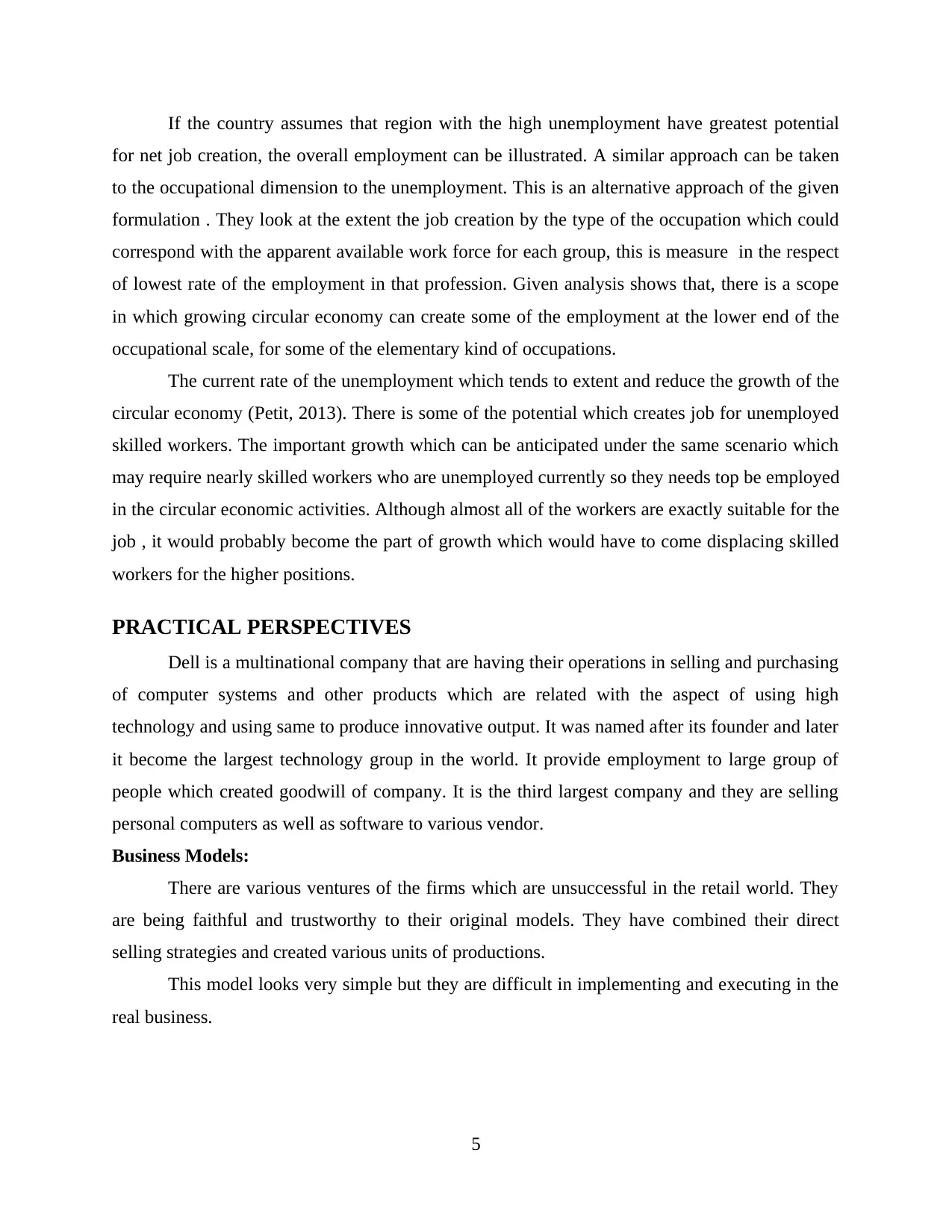
If the country assumes that region with the high unemployment have greatest potential
for net job creation, the overall employment can be illustrated. A similar approach can be taken
to the occupational dimension to the unemployment. This is an alternative approach of the given
formulation . They look at the extent the job creation by the type of the occupation which could
correspond with the apparent available work force for each group, this is measure in the respect
of lowest rate of the employment in that profession. Given analysis shows that, there is a scope
in which growing circular economy can create some of the employment at the lower end of the
occupational scale, for some of the elementary kind of occupations.
The current rate of the unemployment which tends to extent and reduce the growth of the
circular economy (Petit, 2013). There is some of the potential which creates job for unemployed
skilled workers. The important growth which can be anticipated under the same scenario which
may require nearly skilled workers who are unemployed currently so they needs top be employed
in the circular economic activities. Although almost all of the workers are exactly suitable for the
job , it would probably become the part of growth which would have to come displacing skilled
workers for the higher positions.
PRACTICAL PERSPECTIVES
Dell is a multinational company that are having their operations in selling and purchasing
of computer systems and other products which are related with the aspect of using high
technology and using same to produce innovative output. It was named after its founder and later
it become the largest technology group in the world. It provide employment to large group of
people which created goodwill of company. It is the third largest company and they are selling
personal computers as well as software to various vendor.
Business Models:
There are various ventures of the firms which are unsuccessful in the retail world. They
are being faithful and trustworthy to their original models. They have combined their direct
selling strategies and created various units of productions.
This model looks very simple but they are difficult in implementing and executing in the
real business.
5
for net job creation, the overall employment can be illustrated. A similar approach can be taken
to the occupational dimension to the unemployment. This is an alternative approach of the given
formulation . They look at the extent the job creation by the type of the occupation which could
correspond with the apparent available work force for each group, this is measure in the respect
of lowest rate of the employment in that profession. Given analysis shows that, there is a scope
in which growing circular economy can create some of the employment at the lower end of the
occupational scale, for some of the elementary kind of occupations.
The current rate of the unemployment which tends to extent and reduce the growth of the
circular economy (Petit, 2013). There is some of the potential which creates job for unemployed
skilled workers. The important growth which can be anticipated under the same scenario which
may require nearly skilled workers who are unemployed currently so they needs top be employed
in the circular economic activities. Although almost all of the workers are exactly suitable for the
job , it would probably become the part of growth which would have to come displacing skilled
workers for the higher positions.
PRACTICAL PERSPECTIVES
Dell is a multinational company that are having their operations in selling and purchasing
of computer systems and other products which are related with the aspect of using high
technology and using same to produce innovative output. It was named after its founder and later
it become the largest technology group in the world. It provide employment to large group of
people which created goodwill of company. It is the third largest company and they are selling
personal computers as well as software to various vendor.
Business Models:
There are various ventures of the firms which are unsuccessful in the retail world. They
are being faithful and trustworthy to their original models. They have combined their direct
selling strategies and created various units of productions.
This model looks very simple but they are difficult in implementing and executing in the
real business.
5
Paraphrase This Document
Need a fresh take? Get an instant paraphrase of this document with our AI Paraphraser
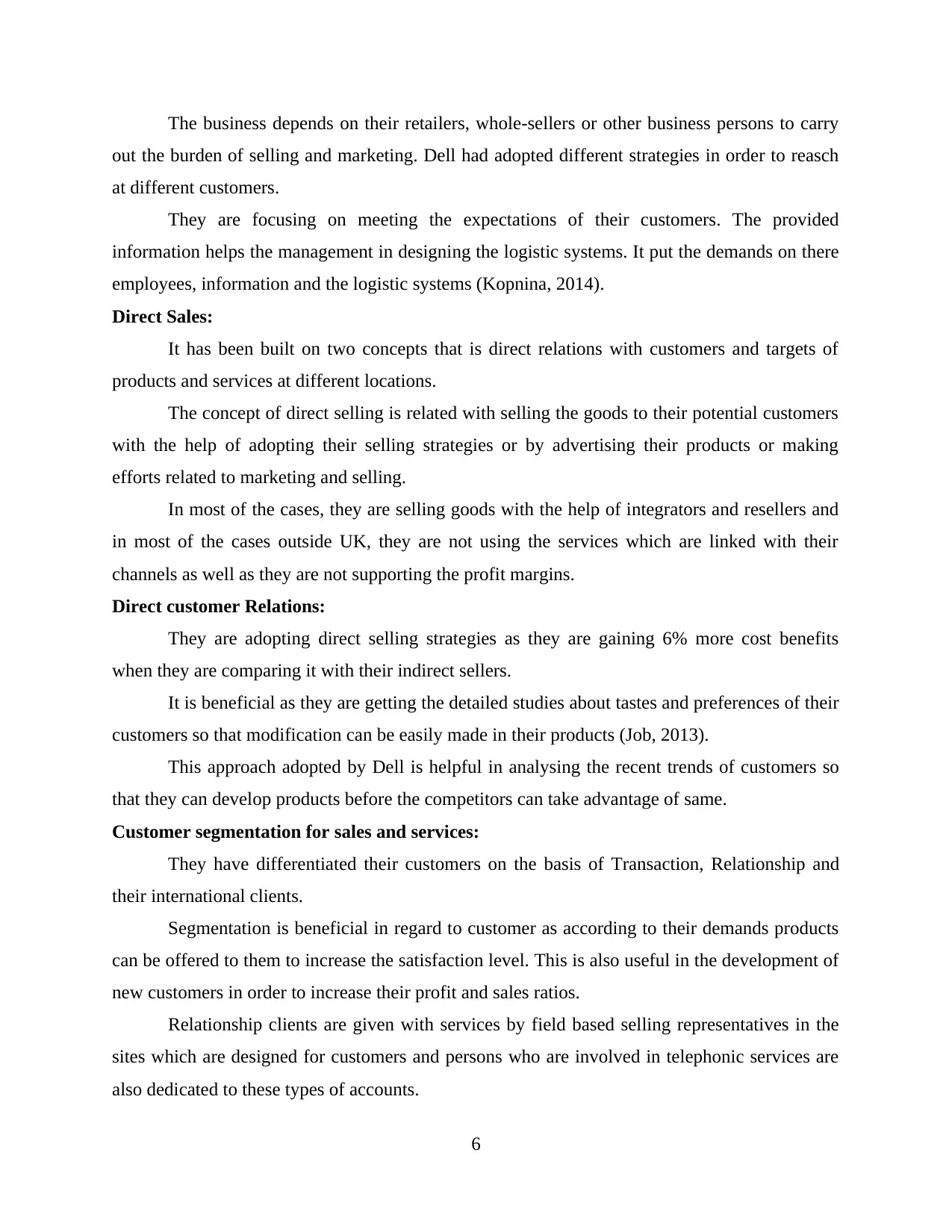
The business depends on their retailers, whole-sellers or other business persons to carry
out the burden of selling and marketing. Dell had adopted different strategies in order to reasch
at different customers.
They are focusing on meeting the expectations of their customers. The provided
information helps the management in designing the logistic systems. It put the demands on there
employees, information and the logistic systems (Kopnina, 2014).
Direct Sales:
It has been built on two concepts that is direct relations with customers and targets of
products and services at different locations.
The concept of direct selling is related with selling the goods to their potential customers
with the help of adopting their selling strategies or by advertising their products or making
efforts related to marketing and selling.
In most of the cases, they are selling goods with the help of integrators and resellers and
in most of the cases outside UK, they are not using the services which are linked with their
channels as well as they are not supporting the profit margins.
Direct customer Relations:
They are adopting direct selling strategies as they are gaining 6% more cost benefits
when they are comparing it with their indirect sellers.
It is beneficial as they are getting the detailed studies about tastes and preferences of their
customers so that modification can be easily made in their products (Job, 2013).
This approach adopted by Dell is helpful in analysing the recent trends of customers so
that they can develop products before the competitors can take advantage of same.
Customer segmentation for sales and services:
They have differentiated their customers on the basis of Transaction, Relationship and
their international clients.
Segmentation is beneficial in regard to customer as according to their demands products
can be offered to them to increase the satisfaction level. This is also useful in the development of
new customers in order to increase their profit and sales ratios.
Relationship clients are given with services by field based selling representatives in the
sites which are designed for customers and persons who are involved in telephonic services are
also dedicated to these types of accounts.
6
out the burden of selling and marketing. Dell had adopted different strategies in order to reasch
at different customers.
They are focusing on meeting the expectations of their customers. The provided
information helps the management in designing the logistic systems. It put the demands on there
employees, information and the logistic systems (Kopnina, 2014).
Direct Sales:
It has been built on two concepts that is direct relations with customers and targets of
products and services at different locations.
The concept of direct selling is related with selling the goods to their potential customers
with the help of adopting their selling strategies or by advertising their products or making
efforts related to marketing and selling.
In most of the cases, they are selling goods with the help of integrators and resellers and
in most of the cases outside UK, they are not using the services which are linked with their
channels as well as they are not supporting the profit margins.
Direct customer Relations:
They are adopting direct selling strategies as they are gaining 6% more cost benefits
when they are comparing it with their indirect sellers.
It is beneficial as they are getting the detailed studies about tastes and preferences of their
customers so that modification can be easily made in their products (Job, 2013).
This approach adopted by Dell is helpful in analysing the recent trends of customers so
that they can develop products before the competitors can take advantage of same.
Customer segmentation for sales and services:
They have differentiated their customers on the basis of Transaction, Relationship and
their international clients.
Segmentation is beneficial in regard to customer as according to their demands products
can be offered to them to increase the satisfaction level. This is also useful in the development of
new customers in order to increase their profit and sales ratios.
Relationship clients are given with services by field based selling representatives in the
sites which are designed for customers and persons who are involved in telephonic services are
also dedicated to these types of accounts.
6
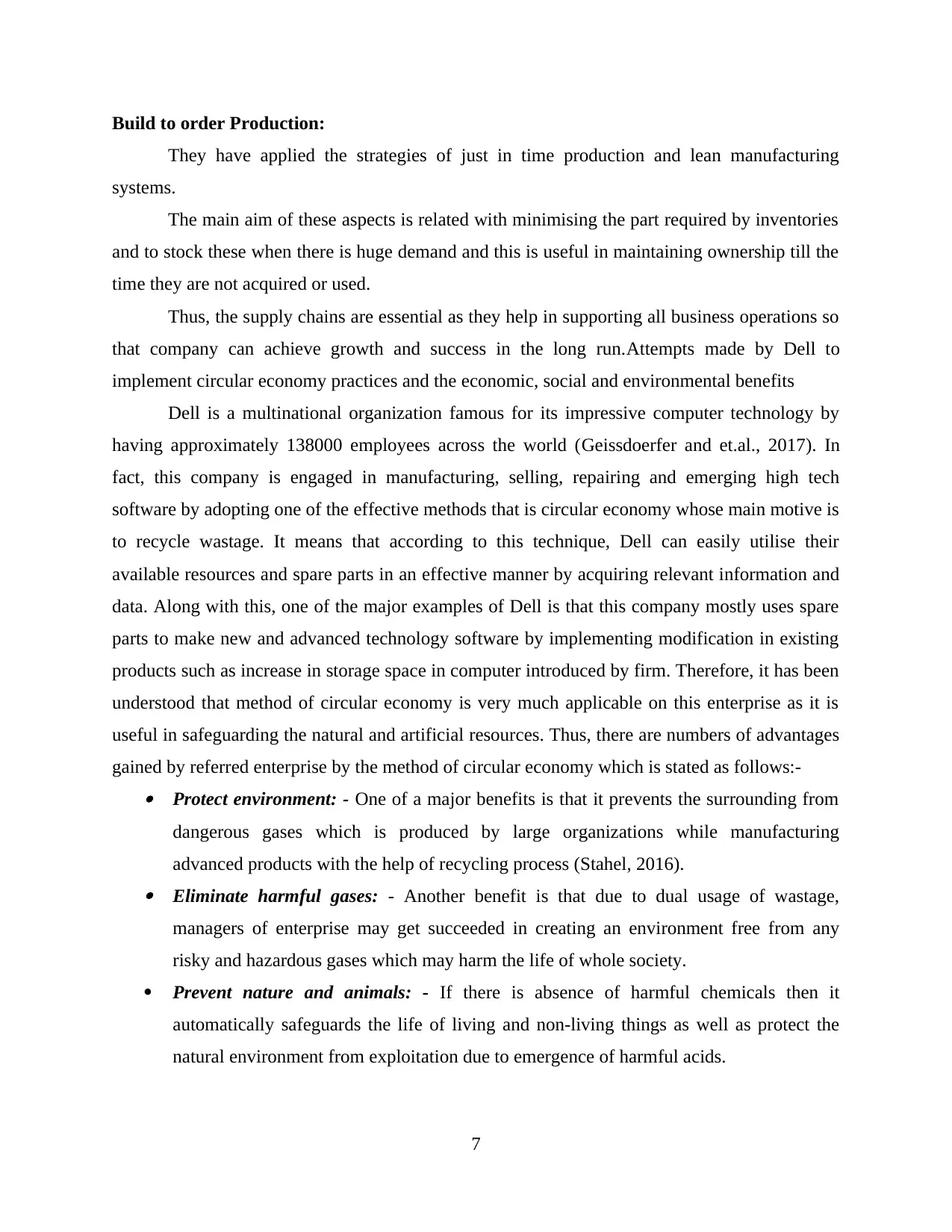
Build to order Production:
They have applied the strategies of just in time production and lean manufacturing
systems.
The main aim of these aspects is related with minimising the part required by inventories
and to stock these when there is huge demand and this is useful in maintaining ownership till the
time they are not acquired or used.
Thus, the supply chains are essential as they help in supporting all business operations so
that company can achieve growth and success in the long run.Attempts made by Dell to
implement circular economy practices and the economic, social and environmental benefits
Dell is a multinational organization famous for its impressive computer technology by
having approximately 138000 employees across the world (Geissdoerfer and et.al., 2017). In
fact, this company is engaged in manufacturing, selling, repairing and emerging high tech
software by adopting one of the effective methods that is circular economy whose main motive is
to recycle wastage. It means that according to this technique, Dell can easily utilise their
available resources and spare parts in an effective manner by acquiring relevant information and
data. Along with this, one of the major examples of Dell is that this company mostly uses spare
parts to make new and advanced technology software by implementing modification in existing
products such as increase in storage space in computer introduced by firm. Therefore, it has been
understood that method of circular economy is very much applicable on this enterprise as it is
useful in safeguarding the natural and artificial resources. Thus, there are numbers of advantages
gained by referred enterprise by the method of circular economy which is stated as follows:- Protect environment: - One of a major benefits is that it prevents the surrounding from
dangerous gases which is produced by large organizations while manufacturing
advanced products with the help of recycling process (Stahel, 2016). Eliminate harmful gases: - Another benefit is that due to dual usage of wastage,
managers of enterprise may get succeeded in creating an environment free from any
risky and hazardous gases which may harm the life of whole society.
Prevent nature and animals: - If there is absence of harmful chemicals then it
automatically safeguards the life of living and non-living things as well as protect the
natural environment from exploitation due to emergence of harmful acids.
7
They have applied the strategies of just in time production and lean manufacturing
systems.
The main aim of these aspects is related with minimising the part required by inventories
and to stock these when there is huge demand and this is useful in maintaining ownership till the
time they are not acquired or used.
Thus, the supply chains are essential as they help in supporting all business operations so
that company can achieve growth and success in the long run.Attempts made by Dell to
implement circular economy practices and the economic, social and environmental benefits
Dell is a multinational organization famous for its impressive computer technology by
having approximately 138000 employees across the world (Geissdoerfer and et.al., 2017). In
fact, this company is engaged in manufacturing, selling, repairing and emerging high tech
software by adopting one of the effective methods that is circular economy whose main motive is
to recycle wastage. It means that according to this technique, Dell can easily utilise their
available resources and spare parts in an effective manner by acquiring relevant information and
data. Along with this, one of the major examples of Dell is that this company mostly uses spare
parts to make new and advanced technology software by implementing modification in existing
products such as increase in storage space in computer introduced by firm. Therefore, it has been
understood that method of circular economy is very much applicable on this enterprise as it is
useful in safeguarding the natural and artificial resources. Thus, there are numbers of advantages
gained by referred enterprise by the method of circular economy which is stated as follows:- Protect environment: - One of a major benefits is that it prevents the surrounding from
dangerous gases which is produced by large organizations while manufacturing
advanced products with the help of recycling process (Stahel, 2016). Eliminate harmful gases: - Another benefit is that due to dual usage of wastage,
managers of enterprise may get succeeded in creating an environment free from any
risky and hazardous gases which may harm the life of whole society.
Prevent nature and animals: - If there is absence of harmful chemicals then it
automatically safeguards the life of living and non-living things as well as protect the
natural environment from exploitation due to emergence of harmful acids.
7
⊘ This is a preview!⊘
Do you want full access?
Subscribe today to unlock all pages.

Trusted by 1+ million students worldwide
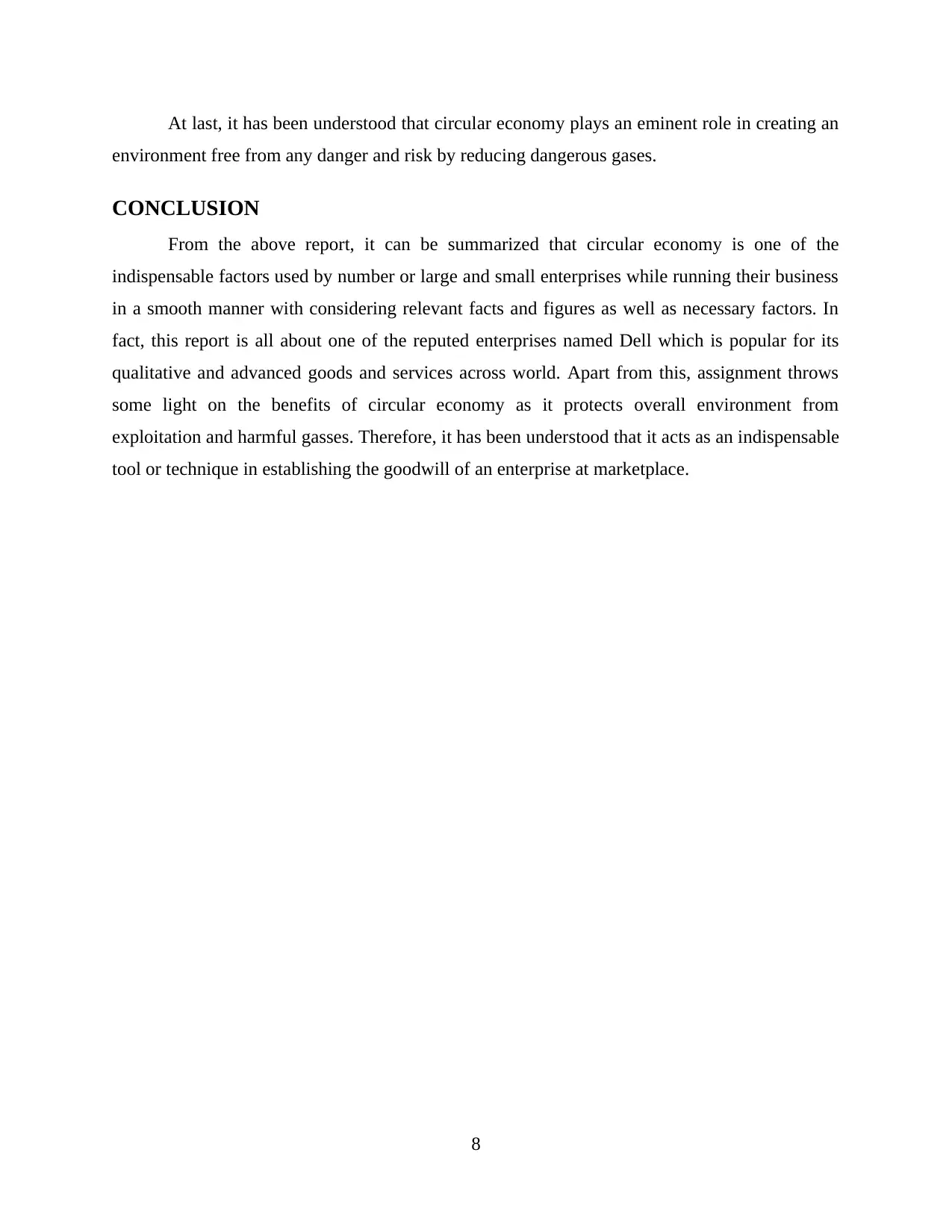
At last, it has been understood that circular economy plays an eminent role in creating an
environment free from any danger and risk by reducing dangerous gases.
CONCLUSION
From the above report, it can be summarized that circular economy is one of the
indispensable factors used by number or large and small enterprises while running their business
in a smooth manner with considering relevant facts and figures as well as necessary factors. In
fact, this report is all about one of the reputed enterprises named Dell which is popular for its
qualitative and advanced goods and services across world. Apart from this, assignment throws
some light on the benefits of circular economy as it protects overall environment from
exploitation and harmful gasses. Therefore, it has been understood that it acts as an indispensable
tool or technique in establishing the goodwill of an enterprise at marketplace.
8
environment free from any danger and risk by reducing dangerous gases.
CONCLUSION
From the above report, it can be summarized that circular economy is one of the
indispensable factors used by number or large and small enterprises while running their business
in a smooth manner with considering relevant facts and figures as well as necessary factors. In
fact, this report is all about one of the reputed enterprises named Dell which is popular for its
qualitative and advanced goods and services across world. Apart from this, assignment throws
some light on the benefits of circular economy as it protects overall environment from
exploitation and harmful gasses. Therefore, it has been understood that it acts as an indispensable
tool or technique in establishing the goodwill of an enterprise at marketplace.
8
Paraphrase This Document
Need a fresh take? Get an instant paraphrase of this document with our AI Paraphraser

REFERENCES
Books and Journals
Stahel, W.R., 2016. Circular economy: a new relationship with our goods and materials would
save resources and energy and create local jobs. Nature. 531(7595). pp.435-439.
Geissdoerfer and et. Al., 2017. The Circular Economy–A new sustainability paradigm?. Journal
of Cleaner Production. 143. pp.757-768.
Job, S., 2013. Recycling glass fibre reinforced composites–history and progress. Reinforced
Plastics.57(5). pp.19-23.
Kopnina, H., 2014. Christmas tale of (un) sustainability: reflecting on consumption and
environmental awareness on the streets of Amsterdam. Sustainable Cities and Society.10.
pp.65-71.
Petit, P., 2013. Slow growth and the service economy. Bloomsbury Publishing.
Skeldon, R., 2012. Going round in circles: circular migration, poverty alleviation and
marginality. International Migration. 50(3). pp.43-60.
Jonker, J., 2012. New Business Models: an explorative study of changing transactions creating
multiple value (s). Doetinchem: Jab management consultants bv.
Klein, A., 2013. The Moral Economy of Somali Piracy–Organised Criminal Business or
Subsistence Activity?. Global Policy. 4(1). pp.94-100.
Sinha, A., 2011. Trade and the Informal economy. Trade and Employment. 125.
Corrêa, H.L. and Xavier, L.H., 2013. Concepts, design and implementation of Reverse Logistics
Systems for sustainable supply chains in Brazil. JOSCM: Journal of Operations and
Supply Chain Management. 6(1). p.1.
Muegge, S., 2012. Business model discovery by technology entrepreneurs. Technology
Innovation Management Review. 2(4).
Nizami, A.S and et. Al., 2017. Waste biorefineries: Enabling circular economies in developing
countries. Bioresource technology.
Zárate-Hoyos, G.A., 2014. A new view of financial flows from labor migration: a social
accounting matrix perspective. Estudios Interdisciplinarios de America Latina y El
Caribe. 10(2).
ONLINE
The circular economy: job creation and the Green Action Plan for SMEs. 2014. Available
through <http://www.eesc.europa.eu/en/our-work/opinions-information-reports/
9
Books and Journals
Stahel, W.R., 2016. Circular economy: a new relationship with our goods and materials would
save resources and energy and create local jobs. Nature. 531(7595). pp.435-439.
Geissdoerfer and et. Al., 2017. The Circular Economy–A new sustainability paradigm?. Journal
of Cleaner Production. 143. pp.757-768.
Job, S., 2013. Recycling glass fibre reinforced composites–history and progress. Reinforced
Plastics.57(5). pp.19-23.
Kopnina, H., 2014. Christmas tale of (un) sustainability: reflecting on consumption and
environmental awareness on the streets of Amsterdam. Sustainable Cities and Society.10.
pp.65-71.
Petit, P., 2013. Slow growth and the service economy. Bloomsbury Publishing.
Skeldon, R., 2012. Going round in circles: circular migration, poverty alleviation and
marginality. International Migration. 50(3). pp.43-60.
Jonker, J., 2012. New Business Models: an explorative study of changing transactions creating
multiple value (s). Doetinchem: Jab management consultants bv.
Klein, A., 2013. The Moral Economy of Somali Piracy–Organised Criminal Business or
Subsistence Activity?. Global Policy. 4(1). pp.94-100.
Sinha, A., 2011. Trade and the Informal economy. Trade and Employment. 125.
Corrêa, H.L. and Xavier, L.H., 2013. Concepts, design and implementation of Reverse Logistics
Systems for sustainable supply chains in Brazil. JOSCM: Journal of Operations and
Supply Chain Management. 6(1). p.1.
Muegge, S., 2012. Business model discovery by technology entrepreneurs. Technology
Innovation Management Review. 2(4).
Nizami, A.S and et. Al., 2017. Waste biorefineries: Enabling circular economies in developing
countries. Bioresource technology.
Zárate-Hoyos, G.A., 2014. A new view of financial flows from labor migration: a social
accounting matrix perspective. Estudios Interdisciplinarios de America Latina y El
Caribe. 10(2).
ONLINE
The circular economy: job creation and the Green Action Plan for SMEs. 2014. Available
through <http://www.eesc.europa.eu/en/our-work/opinions-information-reports/
9
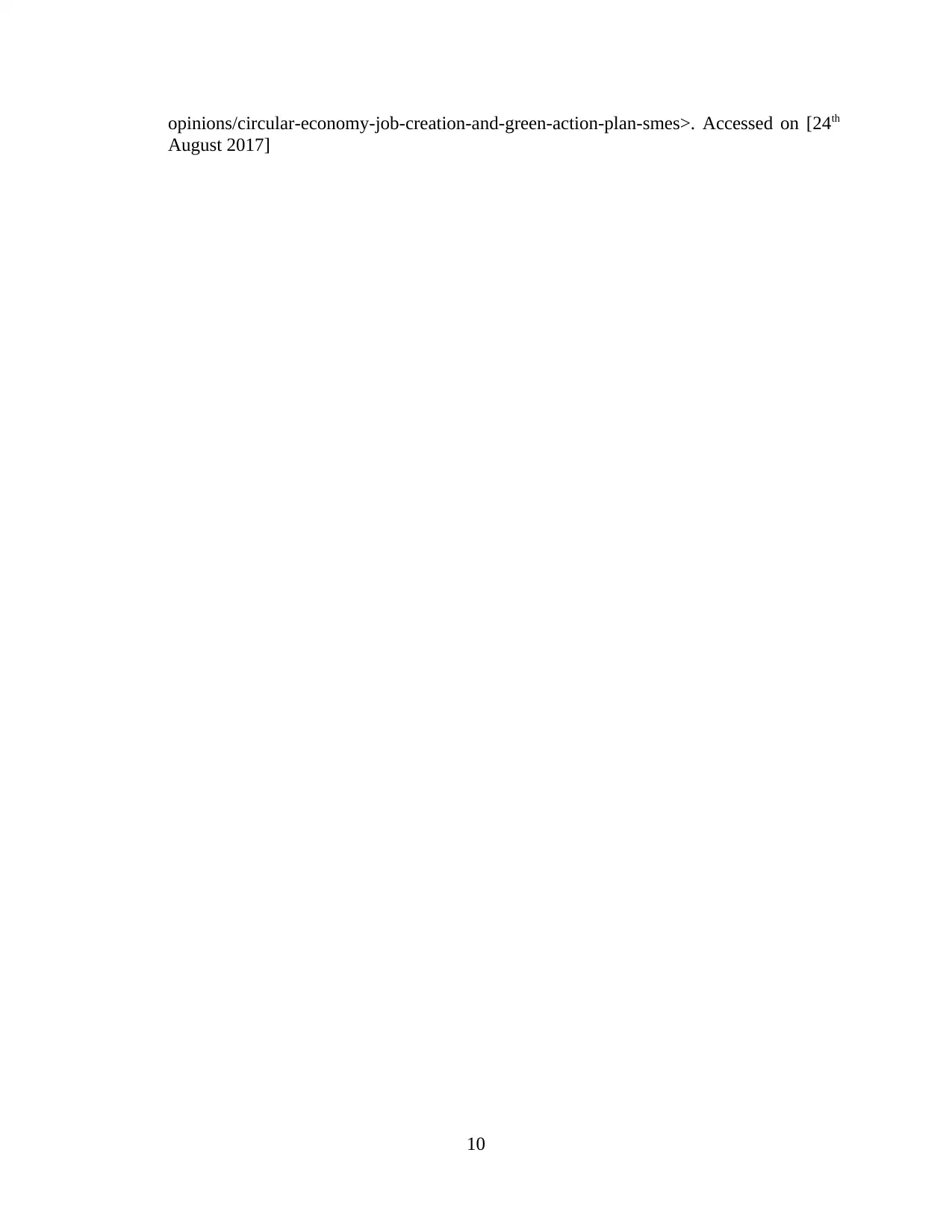
opinions/circular-economy-job-creation-and-green-action-plan-smes>. Accessed on [24th
August 2017]
10
August 2017]
10
⊘ This is a preview!⊘
Do you want full access?
Subscribe today to unlock all pages.

Trusted by 1+ million students worldwide
1 out of 12
Related Documents
Your All-in-One AI-Powered Toolkit for Academic Success.
+13062052269
info@desklib.com
Available 24*7 on WhatsApp / Email
![[object Object]](/_next/static/media/star-bottom.7253800d.svg)
Unlock your academic potential
Copyright © 2020–2025 A2Z Services. All Rights Reserved. Developed and managed by ZUCOL.





